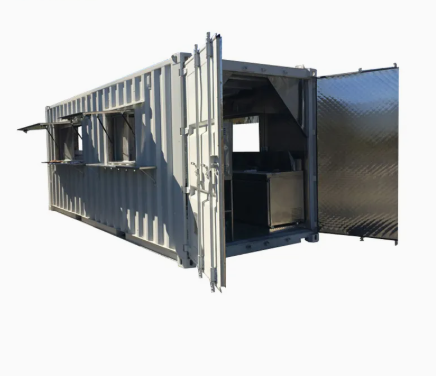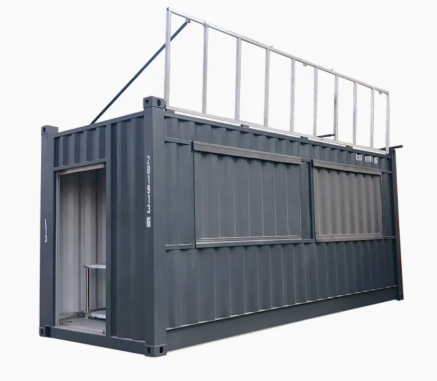In recent years, the demand for container kitchens has surged, especially with the growing trend of mobile food services, pop-up restaurants, and even household applications. Among these container kitchens, the 20ft variant stands out due to its versatility, cost-effectiveness, and practicality. This comprehensive guide aims to explore everything you need to know about 20ft container kitchens for sale, including their benefits, features, setup, customization options, and more, to help you make an informed decision.
1. Introduction to Container Kitchens
What is a Container Kitchen?
A container kitchen is essentially a shipping container that has been transformed into a fully functional kitchen space. These kitchens can serve a variety of purposes, from catering events and food trucks to outdoor cooking areas for personal use. The adaptability and mobility of container kitchens make them an attractive solution for businesses and individuals looking for practical kitchen solutions.
History and Evolution of Container Kitchens
The concept of using shipping containers for commercial purposes began in the early 2000s, primarily driven by the need for cost-effective and portable structures. Over the years, container kitchens have evolved significantly, incorporating modern kitchen equipment, technologies, and design concepts. Today, they are popular in food service businesses, offering an alternative that is not only efficient but also aesthetically appealing.
2. Why Choose a 20ft Container Kitchen?
Size and Space Considerations
A 20ft container kitchen typically offers around 160 to 180 square feet of usable space, making it suitable for small to medium-sized food operations. The design is compact yet functional, allowing for an efficient kitchen layout that can encompass all necessary appliances, cooking areas, storage, and even serving spaces.
Versatility and Mobility
One of the significant benefits of using a 20ft container kitchen is its mobility. Unlike traditional brick-and-mortar setups, container kitchens can be transported from one location to another with relative ease. This feature is particularly beneficial for catering businesses, food festivals, or pop-up events where the operation needs to move frequently.
Cost-Effectiveness
Investing in a container kitchen can often be more cost-effective than a traditional commercial kitchen. The lower initial costs, reduced construction time, and savings on utility costs can collectively contribute to a better return on investment. For entrepreneurs starting out in the food industry, a 20ft container kitchen offers a viable entry point without the burden of large upfront expenses.
Regulations and Compliance
While there are many advantages to container kitchens, it’s important to understand the local regulations regarding commercial kitchens. A properly outfitted 20ft container kitchen can meet health and safety codes, ensuring compliance for food service operations. It’s advisable to consult with local health departments and zoning boards to ensure your container kitchen adheres to all necessary regulations.
3. Key Features of a 20ft Container Kitchen
Layout and Design Options
Designing the interior of your 20ft container kitchen is crucial for maximizing functionality. The layout should facilitate efficient workflow, typically following a line from storage areas to prep spaces, cooking stations, and finally to service areas. Considerations should also be given to natural light and ventilation.
Essential Equipment and Appliances
A 20ft container kitchen can be equipped with a range of appliances:
- Cooking Equipment: This may include ovens, grills, fryers, and stovetops.
- Refrigeration Units: Walk-in coolers, reach-in refrigerators, and freezers are essential to keep ingredients fresh.
- Hot Water Systems: For cleaning and food preparation.
- Storage Options: Shelves, racks, and cabinets for organizing kitchen supplies.
Storage Solutions
Effective storage solutions are vital in a compact space. Installing wall-mounted racks, under-counter cabinets, and pantry storage can significantly optimize available space, keeping the kitchen organized and functional. Repurpose container
Insulation and Environmental Considerations
Insulation is a fundamental feature in a container kitchen to maintain temperature control and enhance energy efficiency. Climatic considerations, such as air conditioning or heating, should also be addressed based on your location and operational hours.
4. Advantages of Buying a 20ft Container Kitchen
Quick Setup and Deployment
One of the standout benefits of a 20ft container kitchen is the quick installation time required for setup. Unlike traditional construction methods, a container kitchen can be operational within days of delivery, making it an excellent choice for entrepreneurs needing a fast entry into the market.
Customization Options
Many suppliers offer a range of customizable options. Businesses can choose the kitchen layout, color, branding elements, and various equipment to tailor the space to their specific needs. Custom branding options allow businesses to create a unique identity.
Sustainability
Container kitchens can be a sustainable choice. Using recycled shipping containers reduces waste and promotes an eco-friendly approach. Moreover, energy-efficient appliances can further enhance the sustainability of your operation, reducing overall carbon footprint.
Mobility and Portability
The ability to relocate a container kitchen easily is invaluable. Whether you want to test a new market, participate in festivals, or adapt to seasonal changes, the mobility of a 20ft container kitchen is a key advantage.
5. Finding 20ft Container Kitchens for Sale
Where to Buy
Several manufacturers and suppliers specialize in container kitchens. It is essential to research and identify reputable companies that offer quality products, good support, and warranties. Online marketplaces, specialized equipment suppliers, and local dealers can be good starting points.
What to Look for in a Supplier
When selecting a supplier, consider factors such as:
- Reputation: Look for reviews and testimonials.
- Customization Options: Ensure they offer the designs and equipment you need.
- Warranty and Support: Knowing that you have support can provide peace of mind.
Price Ranges and Financing Options
The cost of a 20ft container kitchen can vary widely based on customization, equipment, and supplier. Typically, prices can range from $3,000 to over $20,000. Many suppliers offer financing options or installment plans, making it easier for startups to invest in their business without exhausting capital.
6. Setup and Installation
Site Preparation
Before the installation of a 20ft container kitchen, the site must be prepared. Ensure the ground is flat, accessible, and capable of supporting the weight of the container. Adequate drainage must also be in place, especially if the kitchen will be in a permanent location.
Setting Up Utilities
A functional kitchen requires electricity, water, and sewage connections. Building codes will dictate the necessary installation procedures, and hiring certified professionals for these connections is often advisable to guarantee safety and compliance.
Safety and Compliance Measures
Safety should not be overlooked. Ensure that your kitchen layout adheres to all regulations regarding fire safety, health, and local zoning laws. Installing fire suppression systems, proper ventilation, and maintaining a clean workspace are all essential for compliance.
7. Customization and Design Ideas
Interior Design Trends
Container kitchens provide a blank canvas for creativity. It’s essential to not only focus on functionality but also to create an appealing environment that reflects your brand. Popular trends include:
- Industrial Chic: Utilizing the raw appeal of the shipping container with unique finishes.
- Eco-Friendly Designs: Incorporating renewable materials and energy-efficient appliances.
Custom Branding Options
Your container kitchen’s exterior is just as important as its interior. Custom wraps, signage, and paint can all contribute to identifiable branding, drawing in customers through visual appeal. Your branding should communicate your culinary ethos and create a memorable first impression.
Modular Add-ons and Expansion Capabilities
One major advantage of a container kitchen is the potential for expansion. Consider modular designs that allow for add-ons, such as outdoor seating areas, additional storage units, or even additional containers to increase kitchen capacity or functionality.
8. Maintenance of Your Container Kitchen
Regular Maintenance Tips
To ensure longevity and peak performance, establish a regular maintenance routine. This might include:
- Cleaning: Daily cleaning of surfaces and appliances.
- Inspections: Regular checks of equipment for proper functioning.
- Pest Control: Implement preventive measures against pests.
Seasonal Checks
In areas with extreme weather, performing seasonal checks can prevent damage. Ensure that insulation, heating, and cooling systems are in optimal condition before the onset of hot or cold seasons.
Repair and Longevity Considerations
Understanding the lifespan of your container kitchen is crucial. Regular repairs, such as fixing leaks or repainting exteriors, will prolong the usable life of the kitchen. Have a maintenance log to track repairs and inspections.
9. Case Studies and Success Stories
Real-World Applications
Container kitchens have diverse applications. Restaurants looking to expand their operations, caterers needing a mobile solution, and even non-profits providing food assistance have found container kitchens to be invaluable.
User Experiences
Many business owners have shared their positive experiences with container kitchens, highlighting the ease of use, fast setup, and overall functionality. Hear directly from users through testimonials and case studies published online.
Evaluating ROI
Calculating the return on investment for a container kitchen can be straightforward. Consider initial costs versus revenue generated, taking into account factors like customer reach, operational efficiencies, and flexibility in serving varied locations.
10. Future of Container Kitchens
Trends to Watch
The future of container kitchens looks bright. Expect innovations such as:
- Technological Enhancements: From smart kitchen appliances to integrated payment systems.
- Customization Options: More manufacturers offering tailored designs to meet unique needs.
- Sustainable Practices: Environmentally friendly practices becoming more mainstream.
Technological Advancements
Incorporating technology into container kitchens is on the rise. Smart monitoring systems for equipment, ordering apps for food delivery, and social media marketing strategies integrated into the kitchen’s branding can all enhance operational efficiency.
Market Projections
With the ongoing trend towards mobile culinary experiences, the market for container kitchens is poised to grow. Experts predict that as consumers continue to seek unique dining experiences, the demand for portable and versatile food service solutions will increase.
11. Conclusion
Making the Best Choice
Investing in a 20ft container kitchen is a prominent choice for those looking to enter the food service business or expand their current operations. Evaluate your specific needs, budget, and the type of cuisine you want to offer when selecting the right container kitchen.
Final Thoughts
In a world that increasingly values mobility, efficiency, and sustainability, the 20ft container kitchen stands out as a solution that can meet all three of these demands. Whether you’re looking to start a food truck, launch a pop-up restaurant, or enhance your catering business, a container kitchen can perfectly align with your entrepreneurial vision.
This detailed guide provides a comprehensive overview of 20ft container kitchens for sale, addressing important aspects that can assist potential buyers in making informed decisions. As the popularity of container kitchens continues to grow, staying informed about the latest trends and best practices will help ensure your success in this exciting industry.



